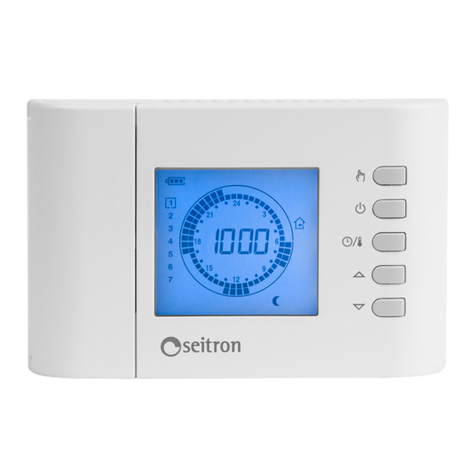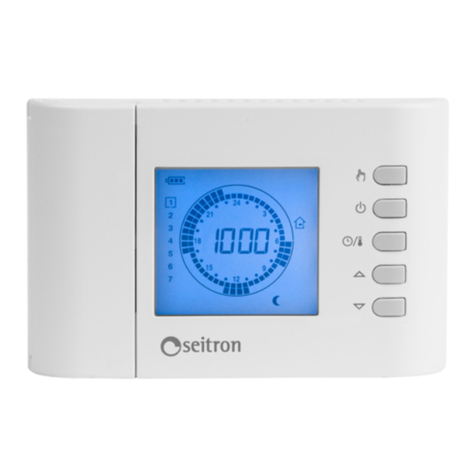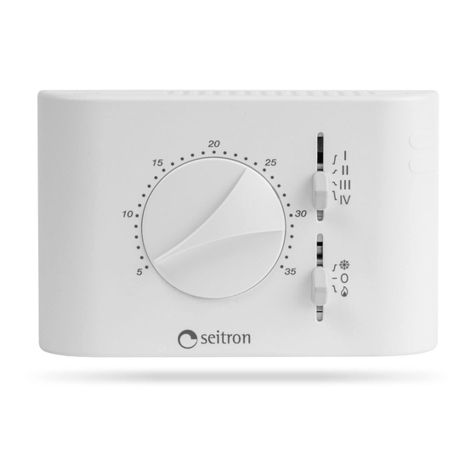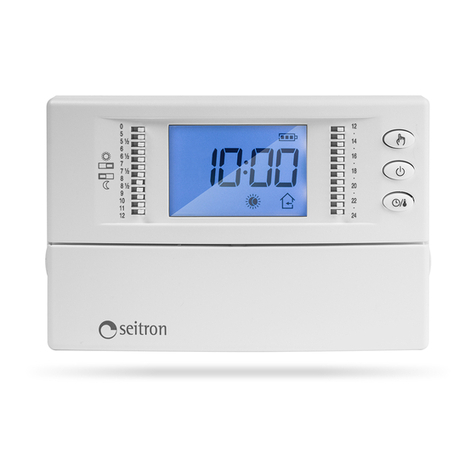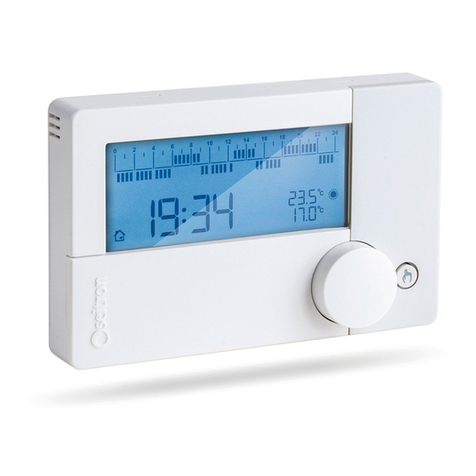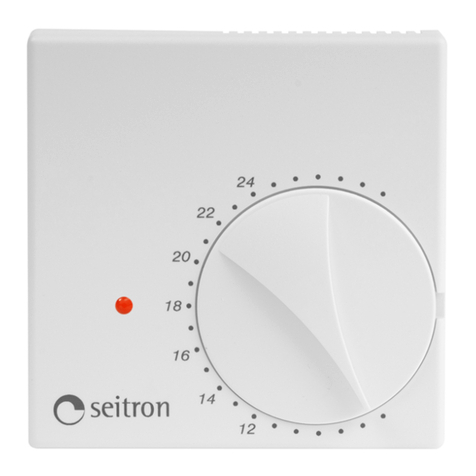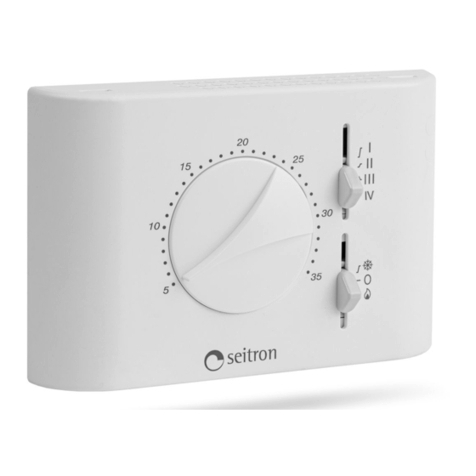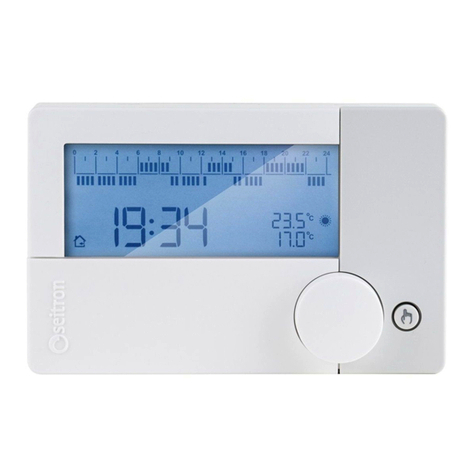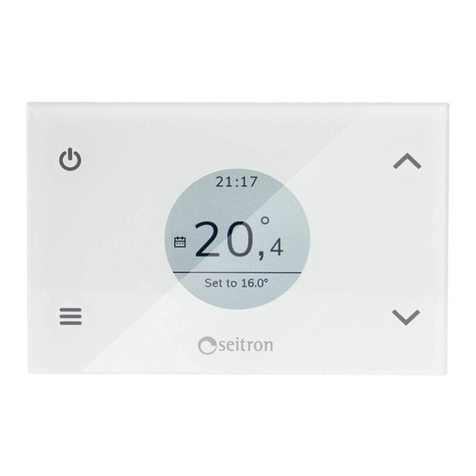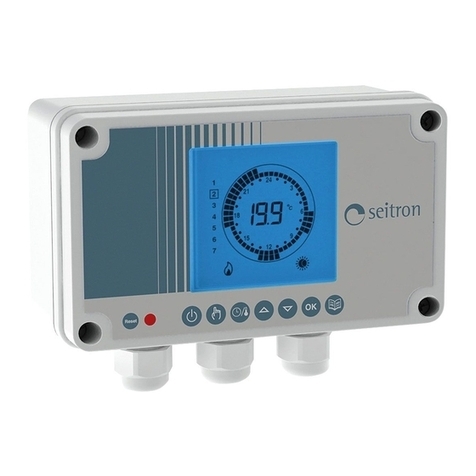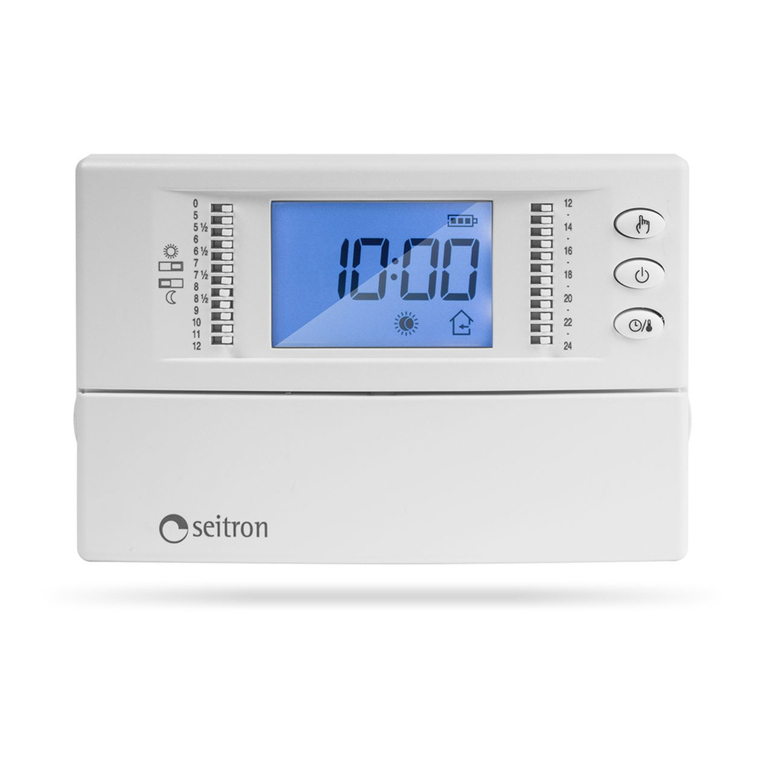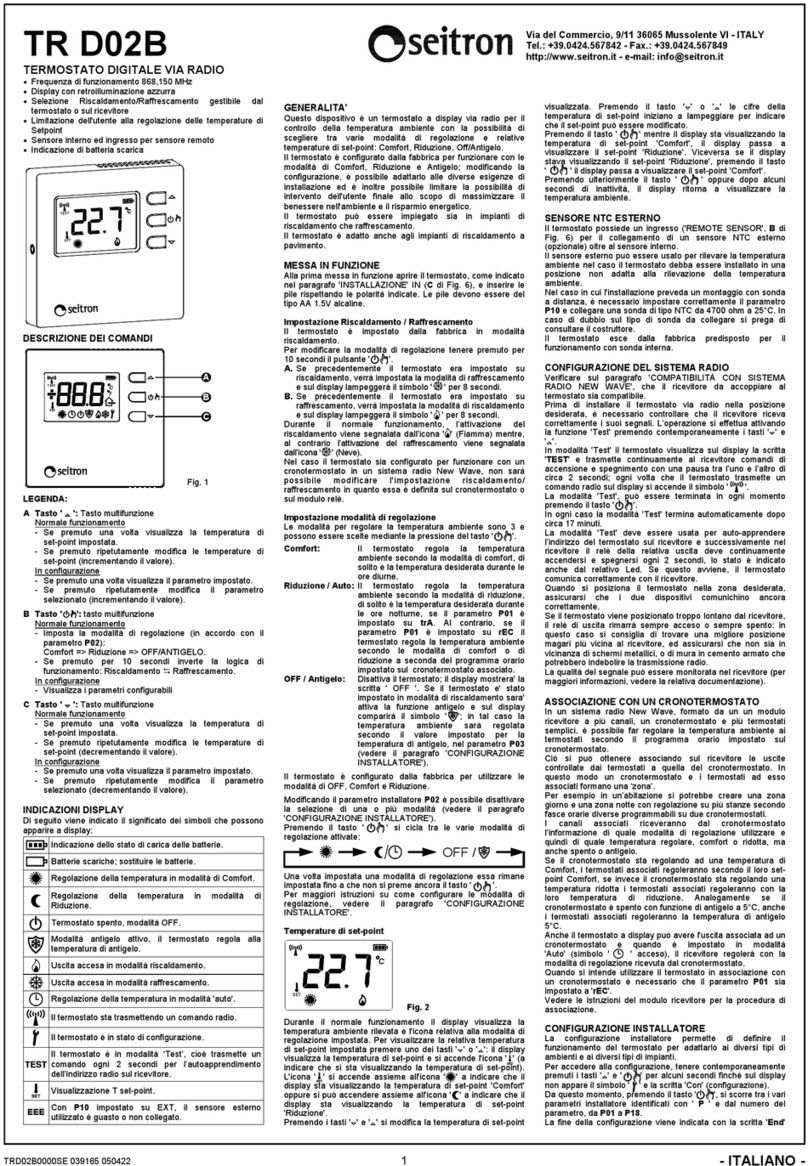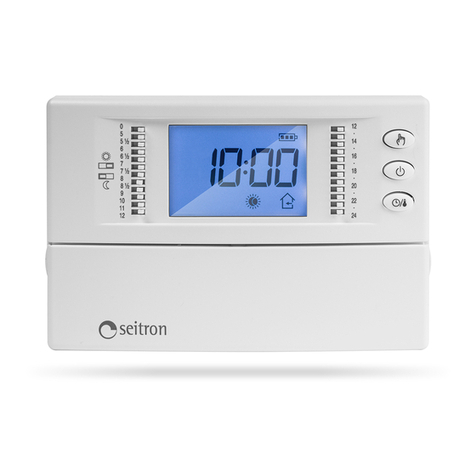
TAS05M0001AN 029756 150218
GÉNÉRALITÉ
Ce thermostat électronique pour systèmes de chauffage est
particulièrement adapté au réglage de la température de manière
précise et fiable pour les habitations, salles, écoles, ateliers, etc. Le
relevé de la température ambiante peut être effectué soit par le capteur
intérieur, soit par la sonde à distance (en option .
FONCTIONNEMENT
Quand la température relevée est inférieure à celle qui est programmée
avec le bouton de réglage, le thermostat active le relais et un LED rouge
positionné frontalement s'allume.
PROGRAMMATION TEMPÉRATURE
Grâce au bouton de réglage, il est possible de régler la température dont
le contrôle sera effectué comme indiqué ci-dessus, champ de réglage
6°C .. 30°C.
BLOCAGE DU BOUTON
Il est possible de réduire le champs de réglage du bouton:
1. Soulever le bouton en faisant levier avec un tourne-vi
(
2
.
2. Extraire les cavaliers mécaniques (4 situés sur les côtés du bouton
et les positionner (5 comme dans l'exemple de la Fig. 5.
De cette façon, le champs de rotation (6 est réduit dans l'arc choisi.
INSTALLATION
a
ATTENTION
-
Pour un réglage correct de la température, il est conseillé
d'installer le thermostat à environ 1,5 m du sol, éloigné des sources
de chaleur, courants d'air ou des parois particulièrement froides
(ponts thermiques). Si une sonde à distance est utilisée, cette note
est appliquée à la sonde et non au thermostat.
- Dans les versions avec sonde à distance, éviter de les placer en
contact avec les câbles de puissance. Utiliser un câble isolé
bipolaire avec mèche libre de section minimum 1,5 mm² (max.
25 m).
- Brancher l'appareil au réseau d'alimentation avec un
interrupteur omnipolaire conforme aux normes en vigueur et
avec une distance d'ouverture des contacts d'au moins 3 mm à
chacun des pôles.
- L'installation et le branchement électrique du dispositif doivent
être réalisés par un personnel qualifié et en conformité aux lois
en vigueur.
- Avant d'effectuer tout type de branchement, s'assurer que le
réseau électrique soit hors tension.
Pour installer le thermostat effectuer les opérations suivantes:
1. Soulever le bouton en faisant levier dans l’emplacement prévu (2.
2. Retirer la calotte de plastique en appuyant vers l'intérieur sur les
deux petites dents de plastique (3 situées sur les côtés.
3. Fixer la base du thermostat au mur au moyen des deux trous prévus
pour les vis avec un interaxe 60 mm (Fig. 4 .
4.
Effectuer les raccordements électriques en faisant passer les fils à
travers l’ouverture rectangulaire (
8
, selon le schéma de la Fig. 7 ou 8.
5. Refermer le thermostat en repositionnant soigneusement la calotte
de sorte que le LED se positionne sur l'emplacement prévu à cet
effet et effectuer une légère pression afin d'enclencher les 4 petites
dents de fixation. Enfin repositionner le bouton de réglage.
RÉDUCTION NOCTURNE (Night Set Back)
Pour activer la modalité 'Réduction Nocturne' (Night Set Back , il faut
connecter un contact externe à la borne 6 (Fig. 7 ou 8 . Cette fonction
permet de réduire la température fixée manuellement par le bouton
d’une valeur égale à celle qui est programmée sur le trimmer interne (7
de Fig. 6, sur une plage entre 2°C .. 7°C. Le thermostat sort de l’usine
avec le trimmer programmé sur 4,5°C.
SÉLECTION SONDE INTÉRIEURE / EXTÉRIEURE
Le thermostat sort d’usine prêt à fonctionner avec une sonde intérieure.
Si l’installation prévoit un montage avec sonde à distance, extraire le
connecteur à bretelle JP1 (9 di Fig. 6 puis brancher une sonde NTC de
- FRANÇAIS -
4
4700 ohm à 25 °C, avec une valeur adéquate pour le paramètre bêta,
aux bornes 7 et 8. En cas de doutes sur le type de sonde à brancher,
consulter le fabricant.
RÉGLAGE OFFSET SUR CAPTEUR INTERNE / SONDE À
DISTANCE
Par un potentiomètre interne (8 de Fig. 6 , placé près du potentiomètre
pour le réglage de la température ambiante, on peut régler la valeur de
l’offset sur le capteur interne ou sur la sonde à distance dans la plage
de -4°C .. +4°C.
- Si le potentiomètre est à l’extrémité de sa rotation anti-horaire
(minimum l’offset est réglé sur -4°C.
- Si le potentiomètre est à l’extrémité de sa rotation horaire (maximum
l’offset est réglé sur +4°C.
- Si le potentiomètre est au milieu (position centrale l’offset est réglé
sur 0°C.
Le thermostat sort d’usine avec le potentiomètre réglé sur 0°C.
CARACTÉRISTI UES TECHNI UES
Alimentation : TA S05M : 230V~ 50Hz
TA S052 : 24V~ 50Hz
Puissance électrique :
TA S05M : 5,3VA
TA S052 : 0,3VA
Champs de réglage : 6°C .. 30°C
Réduction nocturne : 2°C .. 7°C réglable
(Default 4,5°C
Offset capteur interne /
Sonde á distance:
-4°C .. +4°C (Default 0°C
Différentiel : 0,5°C
Type de capteur intérieur : NTC 4k7 ohm @ 25°C
Sonde à distance : NTC 4k7 ohm @ 25°C
(en option
Portée des contacts : 5(1 A 250V~ SPDT
Degré de protection : IP 30
Type d’action : 1
Degré de pollution : 2
Catégorie de surtension : II
Classe de protection contre les
chocs électriques : II
Tension impulsive nominale : 2500V
Indice de localisation (PTI : 175
Nombre de cycles manuel : 50.000
Nombre de cycles automatiques :
100.000
Classe du software : n.a.
Tension essai EMC : 230V~
Courant essai EMC : 25mA
Tolérance distance d’exclusion
mode panne ‘court-circuit’ : ±0,15mm
Température essai sphère : 75°C
Temp. de fonctionnement : 0°C .. 40°C
Temp. de stockage: -10°C .. +50°C
Limite d'humidité : 20% .. 80% RH
(sans condensation
Boîtier: Matière: ABS V0 auto extinctible
Couleur: Blanc de sécurité (RAL9003
Dimensions : 85x85x31 mm (LxHxP
CLASSEMENT SELON LE RÈGLEMENT 2013.811.EC
Classe : I
Contribution à l’efficacité énergétique : 1%
GARANTIE
Dans l’optique d’un développement continu de ses produits, le
constructeur se réserve le droit d’apporter sans préavis, des
modifications aux données techniques et aux prestations de ces
derniers. Selon la Directive Européenne 1999/44/c et le document qui
reporte la politique de garantie du constructeur, le consommateur est
protégé contre les défauts de conformité du produit. Le texte complet
de la garantie est disponible auprès du vendeur sur demande.
TAS05M0001AN 031288 051218
GENERALIDADES
Este termostato electrónico para sistemas de calefacción es apropiado
para la regulación precisa y confiable de la temperatura de ambientes
como, casas, escuelas, salas, oficinas etc. El control de la temperatura
ambiente puede ser efectuado por el sensor interno o bien por la sonda
remota (opcional .
FUNCIONAMIENTO
Cuando la temperatura ambiente detectada es inferior a la ajustada con
el mando giratorio, el termostato activa el relé y contemporaneamente
se enciende el LED rojo ubicado en el frontal.
AJUSTE TEMPERATURA AMBIENTE
Mediante el mando de regulación es posible establecer una temperatura
en torno a la cual será efectuado el control de la temperatura, como
indica el párrafo anterior, en el rango 6°C .. 30°C.
BLO UEO MANDO
Es posible reducir el campo en el que rueda el mando siguiendo los
siguientes pasos:
1. Levantar el mando haciendo palanca con un destornillador en la
embocadura (2.
2. Retire los interruptores de corredera mecánicos (4 ubicados al
costado del asiento del mando y posiciónelos (5 como en el ejemplo
de la Fig. 5.
De este modo el campo de rotación (6 estará reducido como en el
arco indicado.
INSTALACIÓN
a
ATENCIÓN
-
Para una correcta regulación de la temperatura ambiente se
aconseja instalar el termostato a más o menos 1,5 del piso, lejos de
fuentes de calor, corrientes de aire o de paredes particularmente
frías (peuntes térmicos). Si se usa una sonda a distancia la nota
anterior se aplica a la sonda y no al termostato.
- Para la conexión de la sonda usar cables de sección minima 1,5
mm² y longitud max. de 25 m. No pasar los cables de la sonda
en las canaletas de la red eléctrica.
-
Conectar el aparato a la red de alimentación mediante un
interruptor omnipolar conforme a las leyes vigentes y con una
distancia de apertura de los contactos de al menos 3 mm en cada
uno de los polos.
- La instalación y la conexión eléctrica deben ser realizadas por
personas cualificadas y en conformidad con las leyes vigentes.
- Antes de efectuar cualquier conexión asegúrarse que la red
eléctrica esté desconectada.
Para instalar el termostato realizar las siguientes operaciones:
1. Levantar el mando giratorio haciendo palanca con un destornillador
en la embocadura pertinente (2.
2. Sacar la tapa desplazando los dos dientes de plástico (3 ubicados
en el costado derecho del aparato ayudándose con un utensilio.
3. Fijar la base del termostato en la pared mediante con 2
tornillos a una distancia entre ellos de 60 mm (Fig. 4 .
4. Realizar las conexiones eléctricas, haciendo pasar los cables a
través de la apertura rectangular (8, siguiendo el esquema de la
Fig. 7 o 8.
5. Cerrar el termostato posicionando la tapa atentamente de modo que
el LED entre en el orificio y posteriormente ejercite una presión
hasta sentir el chasquido de los dientes de fijación.
REDUCCIÓN NOCTURNA (Night Set Back)
Al borne 6 (Fig. 7 o 8 es posible conectar un contacto externo que
permite activar la modalidad de 'Reducción Nocturna' (Night Set Back .
Esta modalidad permite de reducir la temperatura ajustada con el
mando giratorio de un valor par al ajustado en el trimmer interno (7) de
Fig. 6, en el rango 2°C .. 7°C. El termostato sale de fábrica con el
trimmer ajustado a 4,5°C.
SELECCIÓN SONDA INTERNA / EXTERNA
El termostato sale de fábrica predispuesto para el funcionamiento con
- ESPAŇOL -
5
sonda interna. Si la instalación prevé un montaje con sonda a distancia,
es necesario extraer el conector jumper JP1 (9 di Fig. 6 y conectar una
sonda de tipo NTC de 4700 ohm a 25°C con un adecuado valor para el
parámetro beta a los bornes 7 y 8. Si se tiene dudas respecto el tipo de
sonda que se debe conectar, se aconseja, consultar al constructor.
AJUSTE OFFSET EN SENSOR INTERNO/SONDA REMOTA
Mediante un trimmer interno (8 de Fig. 6 , ubicado cerca del trimmer
para la regulación de la temperatura ambiente, es posible ajustar el
valor del offset en el sensor interno o sonda remota en el rango -4°C ..
+4°C.
- Si el trimmer está completamente girado en el sentido anti-horario
(mínimo el offest está ajustado en -4°C.
- Si el trimmer está completamente girado en el sentido horario
(máximo el offset está ajustado en +4°C.
- Si el trimmer está girado en el medio (posición central el offset está
ajustado en 0°C.
El termostato sale de la fábrica con el trimmer ajustado en 0°C.
CARACTERÍSTICAS TÉCNICAS
Alimentación: TA S05M: 230V~ 50Hz
TA S052: 24V~ 50Hz
Absorción: TA S05M: 5,3VA
TA S052: 0,3VA
Campo de regulación: 6°C .. 30°C
Reducción nocturna: 2°C .. 7°C ajustable
(Default 4,5°C
Offset sensor interno /
sonda remota: -4°C .. +4°C (Default 0°C
Diferencial: 0,5°C
Tipo de sensor interno: NTC 4,7kΩ@ 25°C
Sonda remota: NTC 4,7kΩ@ 25°C
(opcional
Capacidad contactos: 5(1 A 250V~ SPDT
Grado de protección: IP 30
Tipo de acción: 1
Grado de contaminación: 2
Categoría de sobretensión: II
Clase de protección contra
descargas eléctricas: II
Tensión impulsiva nominal: 2500V
Índice de tracking (PTI : 175
Nombre de cycles manuels: 50.000
Número de ciclos automáticos:
100.000
Clase del software: n.a.
Tensión pruebas EMC: 230V~
Corriente pruebas EMC: 25mA
Tolerancia distancia exclusión modo mal
funcionamiento ‘cortocircuito’:
±0,15mm
Temperatura prueba esfera: 75°C
Temp. de funcionamiento: 0°C .. 40°C
Temp. de almacenamiento: -10°C .. +50°C
Límite de humedad: 20% .. 80% RH (no condensable
Caja: Material: ABS V0 autoextinguible
Color: Blanco señal (RAL 9003
Dimensiones: 85x85x31 mm (A x H x P
CLASIFICACIÓN SEGÚN EL REGLAMENTO 2013.811.EC
Calse: I
Contribución a la eficiencia energética: 1%
GARANTÍA
En la óptica de un continuo desarrollo de los propios productos, el
fabricante, se reserva el derecho de aportar modificaciones a los datos
técnicos y prestaciones sin previo aviso.
El consumidor está garantizado contra defectos de conformidad del
producto según la Directiva Europea 1999/44/c y con el documento
sobre la políitica del constructor.
A pedido del cliente se encuentra disponible en el negocio vendedor el
texto completo de la garantía.
